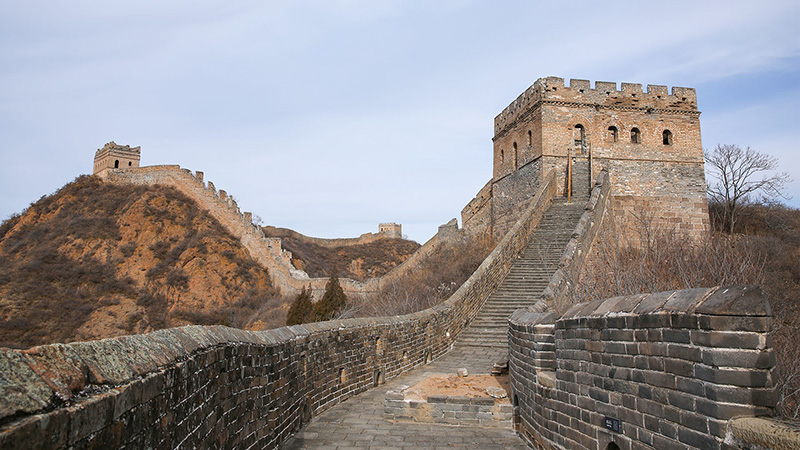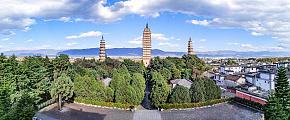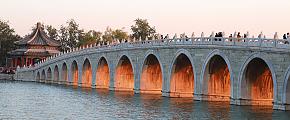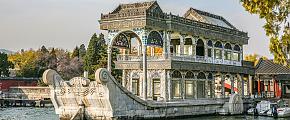Great Wall of China
One of the New Seven Wonders of the World
The Great Wall of China was selected as one of the new Seven Wonders of the World in a global poll announced on July 7, 2007. "If you haven't climbed the Great Wall, you haven't seen China." Many of your friends who did China tours before might have told you this. It is, indeed, an experience of a lifetime.
The Great Wall, one of the most awe-inspiring man-made projects in the world, lies across the northern part of China like a great sleeping dragon, winding its way through China's vast northern territory. With a history of over 2,500 years, the Great Wall attracts visitors from all over the world. In 1987, it was listed on UNESCO's World Heritage List.
 The Great Wall
The Great Wall
History & Function
The construction of the Great Wall began during 770-476 BC. During that period Ducal states built walls to defend their territories. In 221 BC, Qin Shi Huang conquered the six kingdoms and unified China to become its first emperor. To consolidate the country and ward off the invasion by the ethnic minority tribes in the north, he had the separate walls joined together and extended to form a united defensive system. Construction continued up to the Ming dynasty (1368–1644) when the Great Wall became the world's largest military structure.
Construction - He Who Does Not Reach the Great Wall Is Not a Real Hero!
The Great Wall was constructed using the Chinese people's sweat, blood, and muscle. Ancient records show that at least one million slaves and prisoners of war were conscripted to build the Great Wall which followed the contour of the land, taking advantage of the natural landscape. As many died from exhaustion and starvation while working on this colossal task, the Wall was also known as "the longest cemetery in the world."
The bricks, rocks, and lime used to build the wall had to be carried up the mountains on bare backs. Those who succeeded in climbing the wall today are often regarded as "real heroes", but as visitors realize the difficulty in climbing the wall, they should try to imagine how difficult it must have been to build the Great Wall without any modern machinery.
Chairman Mao proclaimed that any person who wanted to be a real hero must climb the Great Wall, which has inspired many ambitious visitors.
 He who does not reach the Great Wall is not a real hero!
He who does not reach the Great Wall is not a real hero!
The Legend of Meng Jiangnu Bringing Down a Section of the Great Wall with Her Tears
Many beautiful legends have survived about the construction of the Great Wall. Among them, the most popular is the story about Lady Meng Jiangnu.
On the night of their wedding, Meng Jiangnu's husband was conscribed to work on the Great Wall by the Qin soldiers. Before he went away, Lady Meng broke her white jade hairpin in two and gave her husband one half as a token of love. One day, lady Meng dreamed that her husband was constantly yelling "Cold, cold". She recalled that her husband was wearing very thin clothes. She made some padded clothes for her husband and left home to look for her husband. She didn't expect that her husband had already died of exhaustion. Upon hearing this, she burst into tears. The Great Wall was moved and more than 20 Kilometers collapsed, revealing the body of her husband and many others. On seeing this, she committed suicide by jumping into the sea.
A temple can be found at Shanhai Pass near the sea in memory of this loyal lady.
Length
The current measurement of this defensive wall, which stretches from Shanhaiguan Pass in the east to Jiayuguan Pass in the west, is 7300 kilometers (4300 miles). Its thickness ranges from about 4.5 to 9 meters (15 to 30 feet), and at its highest point is 7.5 meters (25 feet) tall.
Structure
The Ming Dynasty (1368-1644) was the last dynasty in which large-scale construction of the Great Wall took place, and most of the walls we see today were built during the Ming Dynasty.
Its historic and strategic importance is matched only by its architectural significance. It is constructed of locally available materials – stone, rammed earth, large blocks of granite, and bricks. The Great Wall is comprised of not only the walls but also gates, beacon towers, watchtowers, castles, and fortresses.
Beacon Towers
Along the 7300 kilometers (4300 miles) long wall, there are countless beacon towers that were used as signal towers to deliver messages from one place to another. When the enemy invaded in the daytime, heavy smoke was used as a signal; while at night, a large fire would be lit, because the fire was easy to see in the distance. The scale of the smoke and fire signals could reveal the number of invading enemies. The beacon towers were set at regular intervals along the Great Wall, and each tower upon seeing a signal from the previous one would light its signal to signal the next tower. A signal could be sent from one end of the Great Wall to the other, a distance of 7300 kilometers (4300 miles) in just over one hour.
 The Great Wall's Beacon Towers
The Great Wall's Beacon Towers
Watch Towers
The watchtowers are built at intervals of 1,500 feet except where the terrain is more complicated, and then they are even closer. In ancient times, every day thousands of soldiers were stationed there to make sure the whole nation was safe. At night, they slept inside the towers.
The Great Wall Near Beijing
Factors, such as season, accessibility, safety, and health condition, should be taken into account when visiting the Great Wall. The view as you climb to the top is stunning. Badaling and Juyong Pass is the most visited and most easily accessible part of the Wall. The section between Jinshanling and Simatai requires more physical stamina to climb. The scenery of the Mutianyu Great Wall is extremely beautiful in autumn when the trees covering the mountainsides have turned golden.
Badaling Great Wall
The best-preserved and most imposing section of the Great Wall is at Badaling, which is located 72 kilometers (45 miles) away at northwest of Beijing. In Chinese, 'Bada' means 'giving access to every direction. The name itself suggests its strategic importance. This section is made of large blue bricks. The wall has an average height of 7 meters (24 feet) and a width of 6 meters (19 feet) at the bottom and 5 meters (16 feet) at the top. It is wide enough to allow ten soldiers to march side by side along the wall. The highest point here is more than 731 meters (2,400 feet) above sea level. The Badaling Great Wall is what you should not skip in your Beijing tours.
Mutianyu Great Wall
Mutianyu Great Wall is located 70 kilometers (43 miles) from the center of Beijing. It is much steeper than the Badaling Great Wall, and a more challenging climb. This section, older than Badaling, is considered by Chinese and foreign tourists as the best part of the Great Wall. There are fewer people here because the location is less accessible than Badaling. Surrounded by woodland and streams, this section takes on a different look in each season. Blossoming flowers in spring, flowing streams in summer, red leaves in autumn, and white snow in winter make this one of the Great Walls' most photographic spots.
Simatai Great Wall
The Simatai Great Wall is located 120 kilometers (74 miles) from Beijing. It is often described with the following three words: perilous, diverse, and peculiar. This section has not been restored as much as Badaling and much of the section is in a state of ruin with exposed bricks and the ruins of watchtowers. A famous specialist of Great Wall history has stated: "The Great Wall is the best of the Chinese buildings, and the Simatai section is the best of the Great Wall." This section has been named one of the most "excellent cultural relics of the world" by UNESCO.
Jinshanling Great Wall
The Jinshanling Great Wall is located 140 kilometers (87 miles) northeast of Beijing. It features complicated and well-preserved fortification systems. The walls are more solid, the watchtowers are taller and they retain their original Ming Dynasty appearance. Here you can see the Wall is relatively undisturbed and in its original condition. The wall follows the contours of the mountains and stretches off into the distance. The wall has not been restored, so it has a special beauty. It is the section that foreign visitors like the most.
Jiankou Great Wall
About 90 kilometers (55 miles) northeast of the center of Beijing is the very wild and unrestored Jiankou Great Wall. Located on perilous peaks and precipices among undulating mountains, the broken, age-old, simple but solid bricks show a desolate and natural beauty and the unyielding character of the Great Wall. The whole section twists and turns like a fully-bent bow with an arrow nock, and so is named Jiankou (Arrow Nock). As one of the most precipitous sections of the Great Wall of the Ming dynasty, it gradually becomes a hotspot for photography and popular with hikers.
Juyong Pass
Juyong Pass, located in a valley more than 50 kilometers (31 miles) from Beijing, is one of the three greatest passes of the Great Wall. (The other two passes are Jiayu Pass and Shanhai Pass)
The wall we can see today was built in the early Ming Dynasty (1368-1644). The valley where Juyong Pass lies is steep and precipitous, giving Juyong Pass the reputation of being the steepest and most dangerous pass. Juyong Pass and Badaling in the south are vital gateways in the northwest region of Beijing.
Jiayu Pass
Jiayu Pass, located in the northwestern part of Gansu Province, was a pass of strategic importance on the Ancient Silk Road. This section, first built in 1539, is the representative of the Great Wall in western China and is also the western starting point of the Ming Dynasty built section. It has been called: "the most important pass in the world" and "the most strategically significant pass in Hexi".
Quick Question
Related Posts You May Like
What Our Clients Say
SUBSCRIBE TO WIN A FREE TOUR
Subscribe to our newsletter for a chance to win a free 7-day Morocco tour! And more insider travel news, exclusive offers, and inspiration will be sent straight to your inbox.







